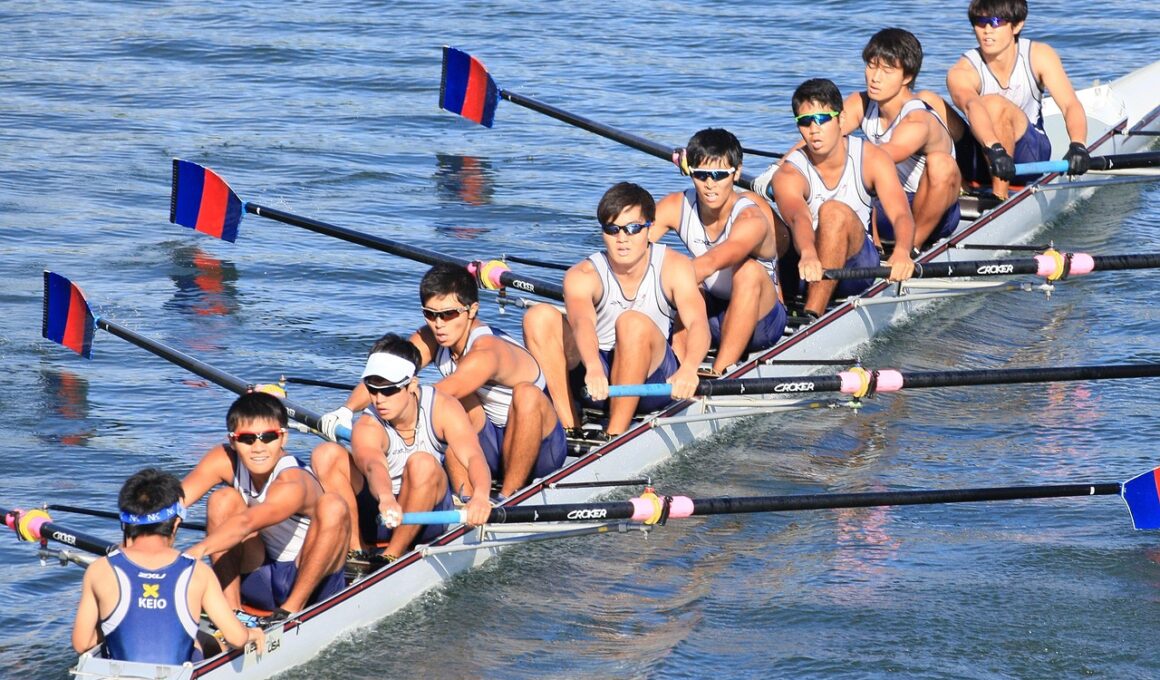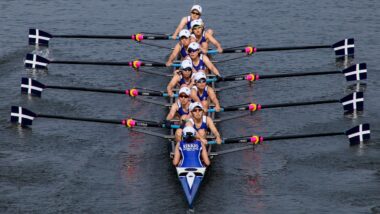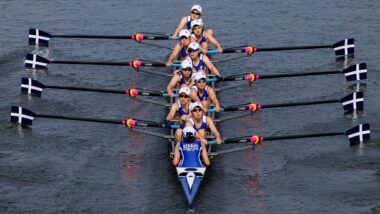Rowing Stroke Length: Definition and Importance
When discussing rowing, the term “stroke length” refers to the distance covered by the boat during a single complete stroke, illustrated by the movement of the oars. The stroke length is critical because it helps determine the efficiency and speed of the boat. A longer stroke can potentially allow for greater boat speed if executed correctly. Rowing performance is influenced by several factors including the rower’s skill, technique, and physical conditioning. Adjusting the stroke length can help optimize the performance for different conditions or personal preferences. For instance, in sprint racing, rowers often employ shorter strokes to maximize their speed. Conversely, in longer races, a longer stroke may prove more efficient over time, conserving energy. Understanding the appropriate stroke length for various scenarios can significantly impact racing outcomes. In training, rowers should focus on finding their ideal stroke length while maintaining proper form and avoiding injury. Coaches often analyze stroke length during practice to provide feedback for improvement. Overall, mastering stroke length is crucial for becoming a successful rower.
To effectively improve stroke length, rowers must engage in specific drills and exercises tailored to enhance their technique. Techniques may include focusing on the timing of their strokes and ensuring that the catch and release points are optimized. Drills such as “single-leg rowing” can help isolate muscle engagement and improve balance and control in the boat. Additionally, athletes can benefit from using video analysis to watch their stroke mechanics in real-time. Coaches can analyze footage and suggest adjustments, leading to more efficient strokes. Strength training off the water is also essential, specifically targeting the back, core, and legs, to ensure rowers have the power to execute longer strokes effectively. Rowing machines, like the ergometer, can aid in simulating water conditions and enable rowers to practice maintaining optimal stroke lengths in a controlled environment. Implementing varied stroke lengths during training sessions prepares athletes for racing scenarios. Ultimately, consistent practice and fine-tuning of stroke length can lead to improved overall performance, better race results, and enhanced personal satisfaction in rowing.
Factors Affecting Stroke Length
Several factors influence the effective stroke length in rowing, including the boat type, environmental conditions, and rower physique. The design of the boat significantly impacts how stroke length is utilized. For example, narrower boats typically allow for longer strokes compared to wider models. Environmental elements like wind and water current also play a role in determining the optimal stroke length for any race. Rowers must learn to adapt their technique based on situational factors such as rough water or unfavorable wind conditions. Individual physiology factors into stroke length effectiveness as well. Taller rowers may naturally have longer limbs, which can accommodate longer strokes. In contrast, shorter rowers may benefit from focusing on quick, powerful strokes to maintain balance and speed. Assessing stroke length should consider these various aspects, allowing rowers to think strategically about each race. Strengthening coordination and timing is vital for maximizing the effectiveness of the stroke, regardless of the individual’s body type. Participation in diverse rowing workouts fosters an understanding of how different elements impact performance.
Rowing stroke length is also significantly shaped by the rower’s technique and experience. Proper technique ensures that a rower can exploit the full potential of their stroke length, thus improving overall efficiency. For instance, an effective catch, where the oar enters the water, needs to be precise to ensure a smooth transition into the drive phase of the stroke. If the catch is rushed or incorrect, it can lead to wasted energy and decreased propulsion. Experienced rowers typically adapt their stroke length through practice, resulting in naturally timed and efficient movements. In racing situations, adapting stroke length based on pace and competitor performance can make a difference in outcomes. Rowers should strive for a balance between maintaining a powerful stroke and sustaining energy levels throughout the race. Employing feedback from coaches and crew members can enhance their understanding of stroke variations. Observing how stroke length fluctuates during high-pressure races can be essential learning experiences. As rowers become more familiar with their conditions, confidence in adjusting stroke length increases.
Conclusion and Best Practices
In conclusion, stroke length in rowing is not merely a metric; it’s a vital aspect of performance that directly impacts speed and efficiency. Rowers must develop a deep understanding of how stroke length works, and how to adapt it based on various influencing factors. Engaging in consistent practice, assessing techniques, and utilizing targeted training can lead the way to substantial improvements in performance. It is essential to identify individual strengths and weaknesses by charting progress over time using metrics provided by coaches or personal assessments. Emphasizing both strength and cardio fitness complements stroke length improvements, making it essential for overall rowing success. As rowers fine-tune their understanding of stroke length, communication with teammates can support collaboration towards shared goals, enhancing crew cohesion. Prioritizing safety and injury prevention should not be overlooked while striving to improve stroke length. The right education around rowing techniques can create youthful enthusiasm while also optimizing competitive performance. Ultimately, refining stroke length delivers the rows necessary to excel in competitions and develop as rowers.
Finally, understanding the importance of stroke length allows rowers to adapt their strategies effectively. When different races demand specialized techniques, being nimble in adjusting stroke length can be precious. Competitors who can successfully manage this aspect of their performance tend to achieve better results. Moreover, analyzing data on stroke length from varied races enables rowers to identify patterns. By recognizing what works in given scenarios, rowers can establish more suitable approaches in subsequent races. Furthermore, taking part in crew discussions helps foster an atmosphere of shared learning. Members should be encouraged to share experiences regarding improvements and challenges associated with stroke length. Ultimately, masters of stroke length not only sharpen their skills but also inspire teammates to elevate their performance. Before every race, it is essential to visualize how stroke length impacts one’s performance from start to finish. Rowers who embrace this mindset emerge with a powerful competitive edge. Therefore, stroke length represents an ongoing journey of learning, adaptation, and commitment to excellence in the pursuit of rowing prowess.
Finally, reflecting on stroke length, rowers should remember the uniquely collaborative nature of the sport. Every crew member’s stroke influences the overall performance, necessitating harmonization across each member. As rowers train, they should strive for cohesion to ensure that varying stroke lengths complement each other, resulting in streamlined movement and improved speed. Group drills focused on synchronization can be useful for achieving this goal. In addition, experimenting with measuring the performance benefits of varied stroke lengths can provide exciting insights. Some teams may find specific length adjustments lead to significant speed or endurance improvements. Documenting observations and experiences while adjusting stroke lengths fosters continuous learning. Participating in races offers the chance to observe how implemented changes play out in real conditions. As rowers progress through competitions, let them appreciate how fundamentals—such as stroke length—connect to overall performance in racing environments. Ultimately, embracing stroke length improvement is crucial not just for individual success but also for contributing to the collective triumph of the crew.
As rowers increasingly focus on refining their skills, do not forget that stroke length evolves as part of a broader strategy in rowing. Focusing on health, conditioning, and teamwork helps build a well-rounded athlete capable of facing challenges on the water. Therefore, as rowers navigate their training journey, emphasizing stroke length remains integral for sustained success. Exploring new strategies and practices helps discover improved sequencing in strokes, fostering greater engagement in rowing. Utilizing education regarding technique and contextual application of stroke length can further help rowers gain an upper hand. Furthermore, team support enhances motivation and accountability, all contributing to a more profound commitment to improving stroke efficiency. Ultimately, consistent dedication to refining stroke length creates a more agile, powerful, and effective rowing performance regardless of the conditions faced. If rowers embrace a lifelong learning attitude, they can continually adapt and persevere, leading to significant personal gains. Emphasizing stroke length in training represents not only a performance enhancer but also a deeper understanding of the art and science of rowing. In total, stroke length embodies a vital aspect of rowing that must be mastered for optimal performance.





